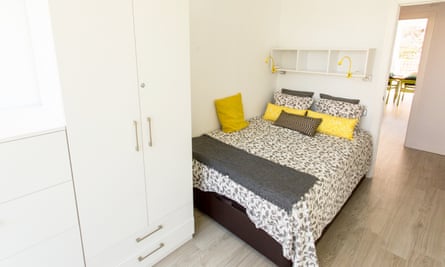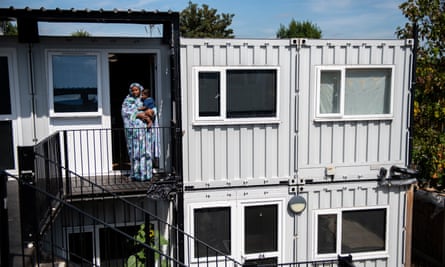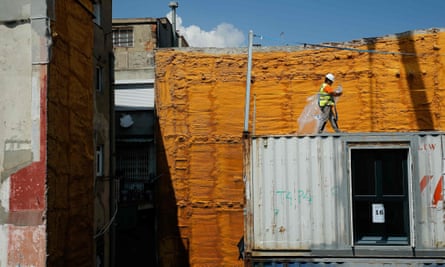Barcelona has begun installing its first shipping container homes just a stone’s throw from La Rambla, the famous thoroughfare in the city centre, in a bid to provide emergency housing for people who have been evicted or otherwise driven out of the neighbourhood by gentrification.
Work commenced last week on the 12 small apartments, which are being installed on Carrer Nou de Sant Francesc, a narrow street in the densely populated Ciutat Vella (“old city”) district.
The container scheme, which has raised eyebrows in a city known for its elegant urban landscape, was initially rejected by the council for fear tenants would feel stigmatised. With over 1,000 people on the emergency housing list, however, it was soon revived.
The organisation behind the project is Aprop – an acronym meaning “local provisional housing” that also means “close by” in Catalan – which is working in conjunction with three architectural practices.
David Juárez, an architect at Straddle3, one of the practices involved, says people have an image of a “naff” project but that there is nothing shabby about the one- and two-bedroom flats being constructed.

They will be built to the same standards as conventional housing, with good thermal and sound insulation and under-floor heating, he says, and when the work is complete they will not even be recognisable as containers.
“These container homes are built to a higher standard than much of what is on the rental market in Barcelona,” says the housing activist Jaime Palomera, spokesman for the city’s Tenants’ Union. “This idea that the poor are being forced to live in sardine tins is nonsense.”
But concerns have been raised about this type of housing.
“The biggest problem with containers is insulation, both thermal and noise,” says Co Govers of the Zest Architecture practice in Barcelona, which specialises in low-energy construction.

“That was the big issue when they built student residences in the Netherlands with containers, that they were cold and noisy. You have to add massive amounts of insulation, which is expensive.” Some forms of internal insulation also further reduce the cramped living space.
There has been criticism of a similar scheme in Ealing, west London. The children’s commissioner for England recently criticised container flats as unsuitable and unsafe, and residents have said they are cramped, stiflingly hot in summer, and too cold in winter.
The total cost of the scheme in Barcelona is €940,000 (£840,000). “We can deliver an apartment in a year while a traditional building takes six to eight years to reach completion,” says Tonet Font of the city’s social innovation department. Work is expected to be completed by the end of October.

However, Govers argues that, despite the speed of construction, the flats do not in fact offer value for money: “If they’re producing 12 flats of, say, an average of 45 sq metres for €940,000, that’s not so cheap,” she says. “With that money you could build something new, and something that would be pretty OK, at that. This sounds expensive for temporary housing.”
Barcelona already has an abysmally low level of public housing – 1.5% of the total stock, compared with 28% in Berlin.
Local authorities depend on central government funding to finance building projects but have been starved of cash in recent years. Currently only 0.05% of GDP is set aside for public housing.
Juárez says Aprop’s prime motivation is to resist the tide of gentrification that is driving all but the most well-to-do out of the city centre as speculation and tourist apartments force up rents and house prices.

“Nearly all social housing is built on the outskirts and not in the city centre,” he says. “This is because most of the work on public housing is done by a few big construction companies and they are only interested in big projects.
“We can produce housing in much smaller empty spaces that exist all over the city. And if we can do this in a neighbourhood as dense as Ciutat Vella, we can do it anywhere.”
Palomera says: “What’s been happening in cities is that private investors have been building luxury homes on these sites, and what the council is trying to do is gain some ground on investment funds and produce quality public housing instead.”
The project is scheduled to be taken down after five years if necessary, says Juárez, “but it’s very likely that it will be there a lot longer and, as it meets all the regulations, it could stay as long as any conventional building”.
He is aware of the criticism of container flats in the UK and admits that “building with containers can bring terrible results unless you really make an effort”.
Juárez says residents’ responses have generally been positive. “Those who oppose it are smaller in number but they’re more vocal. I think the majority are positive but are reserving judgment until they see what it looks like.”
Follow Guardian Cities on Twitter, Facebook and Instagram to join the discussion, catch up on our best stories or sign up for our weekly newsletter
